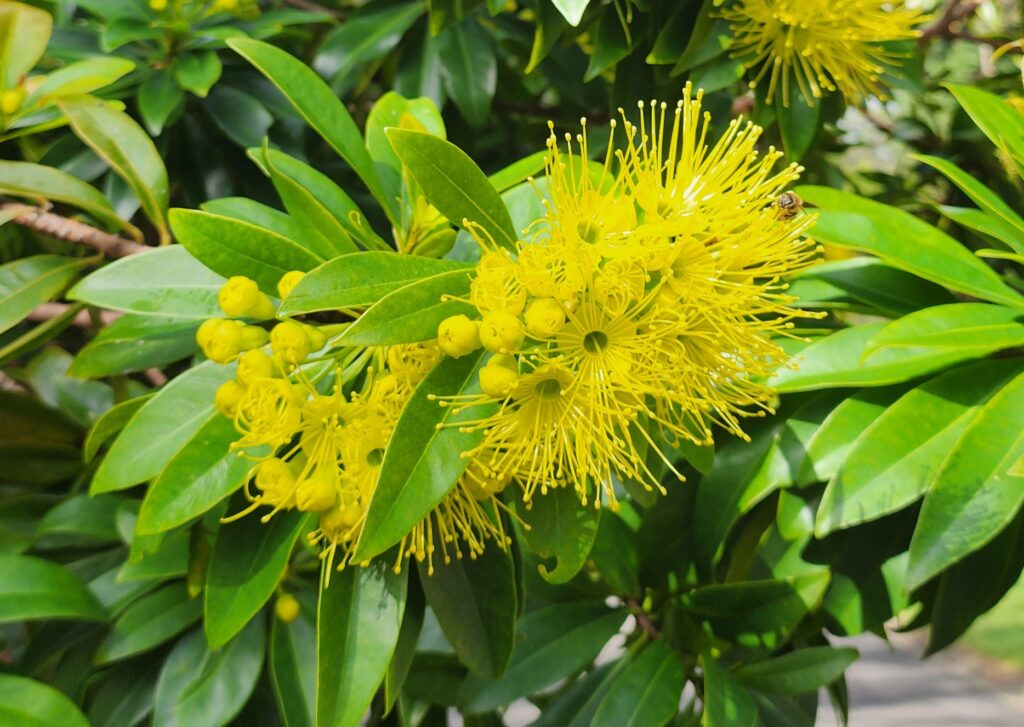Don’t want to see your neighbour?
Don’t want them to see into your backyard?
What you need are screening plants!
Screening plants can involve tall shrubs and even small trees that are dense – very dense – to block views. These species need to have the capacity to create a natural thick foliage cover. Ideally, a plant that is self-shaping, dense and reaches the preferred height is the golden chalice.
Pruning may be needed to keep the plant dense and/or within ideal dimensions. Maintenance to some degree will be needed.
This post looks at the ten (10) most popular ‘best’ screening plants for South East Queensland. The next post (LINK HERE for Part 2) addresses an additional ten (10) that are less popular but are worthy of ranking in the top 20.
Here is a list we highly recommend as the most popular ten (10) screening plants for the local South East Queensland region, for both professional landscape projects and domestic gardens. Order is according to the alphabet.

- Blush Satinash (Syzygium hemilamprum / Acmena hemilampra) – a popular tree for councils but also an impressive screening specimen for large properties. Lovely new growth tips and flowers make this an appealing feature.
- Bottlebrushes (Callistemon viminalis cultivars / Calllistemon citrinus cultivars) – these natives are often overlooked as potential screening plants. Selecting the right cultivar will give you success so we recommend ‘Candy Pink’, ‘Endeavour’, ‘Hannah Ray’, ‘Kings Park Special’, ‘Wildfire’, ‘Wilderness White’, ‘Pink Champagne’, plus others. They have an excellent reputation for attracting wildlife and give a more ‘Aussie’ look to the garden.
- Emerald Lustre (Viburnum odoratissimum ‘Emerald Lustre’) – big glossy leaves make this plant a popular plant for landscapers for blocking out views to the neighbours. Although it does have white flowers in spring, the main feature is the foliage. Normally grown to 2-4m as a hedge or boundary screen.
- Fairhill Gold / Expo Gold (Xanthostemon chrysanthus ‘Fairhill Gold’ / ‘Expo Gold’) – this compact large shrub (small tree) has been used by councils as a screening plant between main roads and housing estates for good reason – it works! The cultivar sold as ‘Fairhill Gold’ (same as ‘Expo Gold’) has fatter leaves, shorter internodes which means it creates a much denser habit compared to the original species. The inflorescence is also far superior to the normal straight species.
- Green Dream (Elaeocarpus reticulatus ‘Green Dream’) – is an improved cultivar of the species with more attractive and dense foliage along with white flowers. This specimen can be clipped into a hedge or screen and left ‘a la natural’ for a more natural landscape design.
- Heliconia – some heliconia cultivars make the perfect screening plant. They complement a tropical style garden and never reach tree proportions. Heliconias may need old stalks cut out (each stalk known as pseudostem only flowers once) to make room for new stalks that will flower. After many (10) years, rhizomes may need to be dug out and replanted. Some of the best screening Heliconias are ‘Hot Rio Nites’, ‘Rauliniana’, ‘Jacquinii’, ‘Kawauchi’, Heliconia pendula ‘Waxy Red’, plus others.
- K’Gari Apple / Fraser Island Apple (Acronychia imperforata) – this native small tree is idea for exposed windy and sandy sites. Normally grown as a traditional tree with trunk and canopy, it is very adaptable to be grown as a bushy screening hedge plant, pruned or unpruned.
- Lillypillies (Syzygium paniculatum / Syzygium australe / Syzygium smithii / Syzygium luehmannii) and their cultivars such as ‘Resilience’, ‘Hinterland Gold’, ‘Aussie Gem’, ‘Big Red’, etc. There are many cultivars on the market that make perfect screening plants. Multiple cultivars mean you can select one that fits your space and leaf colour preference. These Aussie native plants tick all the boxes for environmental reasons.
- Mock Orange/Orange Jessamine (Murraya paniculata) – one of the most popular and hardy plants for our climate. These can be hedged down to 2m height but are best grown at 2-3m height for screening and blocking out neighbours. It is worth noting it can grow into a small tree but is generally grown as a shrub. White flowers are scented which attract abundant bees. Rarely affected by bugs or pests but is known to get borers if stressed. Full sun to part shade is preferred to achieve best dense foliage. [Note: considered a weed in some areas of Australia].
- Summerscent / Everlasting Beauty (Radermachera ‘Summer Scent’ / ‘Everlasting Beauty’) – this is a small tree that is becoming more popular as an alternative to Murraya. Leaves are a lovely dark green and the scented flowers are white to pale pink with yellow throat. Flowers appear abundantly over the warmer months. This plant prefers full sun to part shade. Pruning helps to reinforce the dense habit. Not known to have major pest problems.
The next post (LINK HERE for Part 2 list) addresses an additional ten (10) plants that are less popular but are worthy of ranking in the top 20.
Here at Plant Connections, we can supply these for your landscape projects. Some we grow here and others we can get in for you, depending on availability. Contact us if you are seeking these plants for your landscape project.

